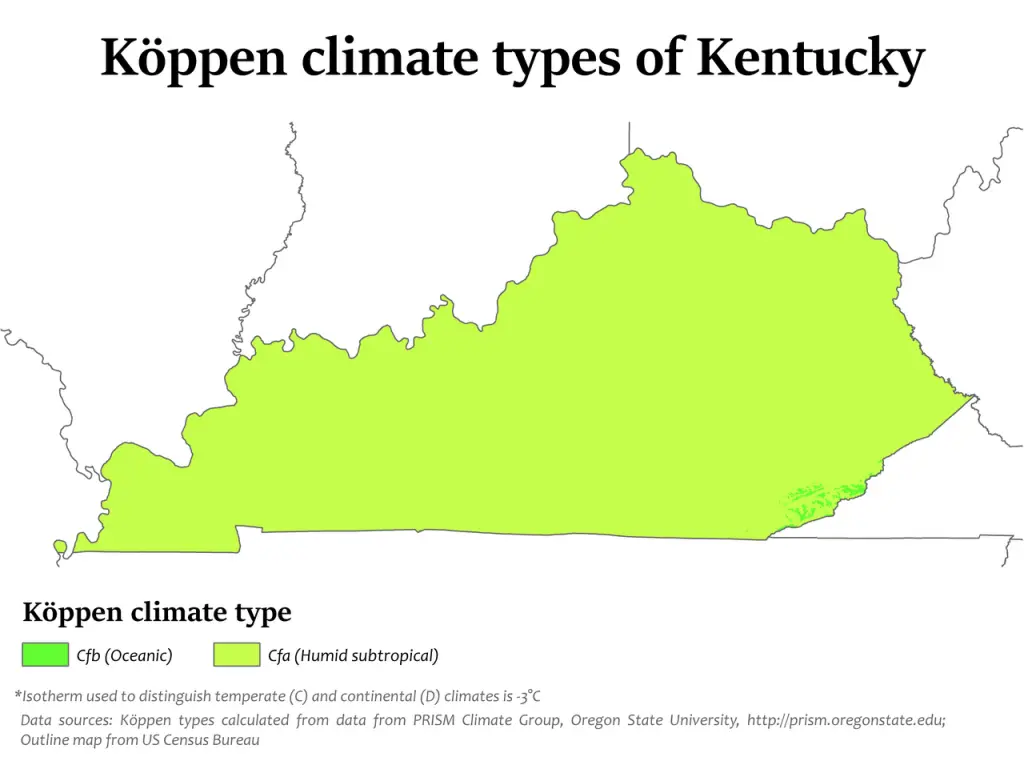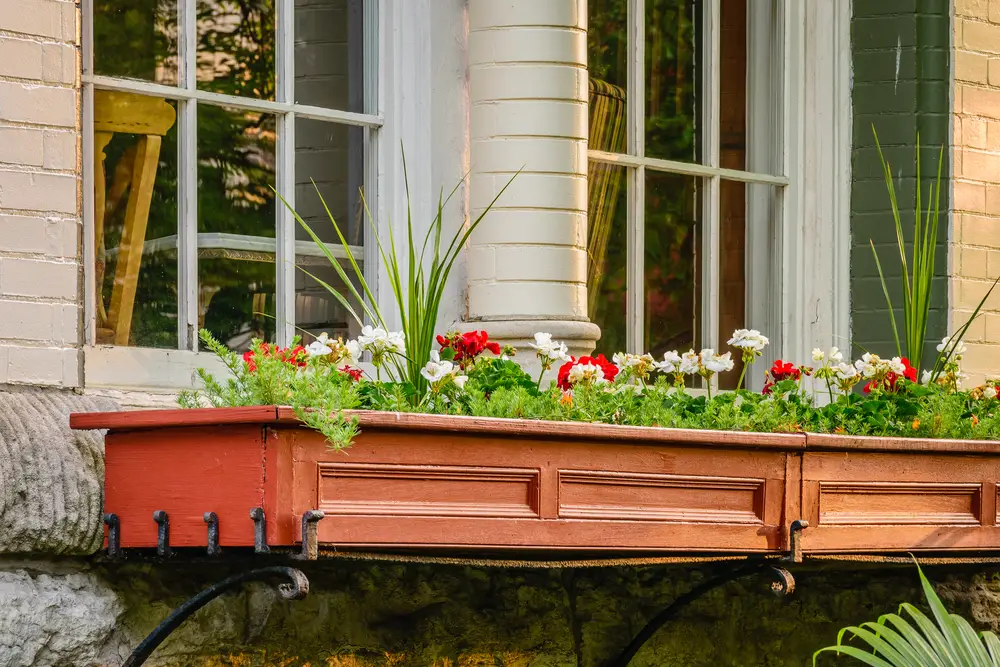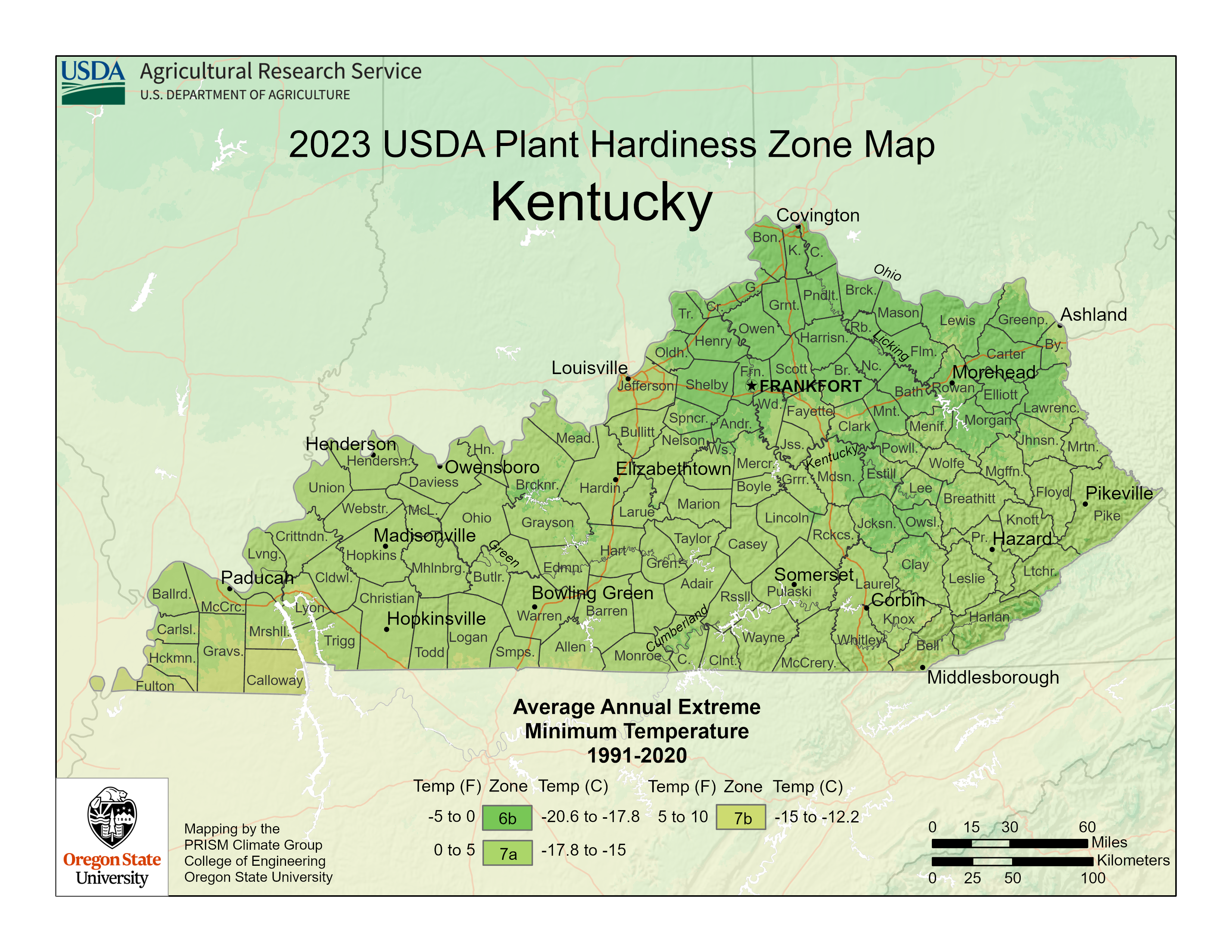Kentucky Plant Hardiness Zones
| USDA Hardiness Zone | Average Minimum Extreme Winter Temperature Range Fahrenheit (°F) Celsius (°C) | Average Last Frost Date Range In Spring (Beginning Of The Growing Season) | Average First Frost Date Range In Autumn (End Of The Growing Season) |
|---|---|---|---|
| 6b | -5°F to 0°F -20.6°C to 17.8°C | Late April to early May | Mid to late October |
| 7a | 0°F to 5°F -17.8°C to -15°C | Late April to early May | Mid to late October |
| 7b | 5°F to 10°F -15°C to -12.2°C | Early to mid-April | Late October to early November |
Kentucky Growing Conditions
General Climate

The Kentucky climate is humid subtropical, with a very small portion of the south in a highland subtropical climate, a subcategory within the oceanic climate range.
Kentucky experiences all four seasons. It has warm summers and moderately cold winters, with the north portion of the state experiencing lows of -5°F (-20.6°C) with snow and ice. Humid subtropical climates typically don’t have a dry season and see rainfall year-round.
Highland subtropical climates exist at higher elevations within the subtropics. Kentucky experiences this climate due to the effects of the Appalachian mountain range. This climate experiences both cooler summers and winters, with less variation in temperature. This climate is also known to be dryer, with less precipitation annually.
Kentucky is known for its Kentucky bluegrass, a cool-season grass that is a popular option for lawns. In the spring, these bluegrass fields are full and fresh, welcoming spring with its crisp, bright blue hues.
Microclimates
USDA plant hardiness zones are an important starting point for your garden, but you’ll also need to consider microclimates.
Microclimates are areas where specific conditions create a climate different from the climate they’re situated in.
Buildings, fences, paved areas, or short hills and valleys can create these microclimates.
They can be as small as a space in your backyard or as large as a city.
In other words, learn about your local conditions from local experts to see if your garden falls into a microclimate.
Extreme Weather
Winter Weather
Kentucky experiences annual winters that can bring blizzards, ice, and sleet. Different areas of Kentucky can experience variations in winter weather, with the southwest receiving less snow compared to the eastern portions.
Cold frames and cold-hardy crops are a great way to beat the cold and extend your growing season. Lots of plants and veggies like parsley, kale, and salad greens can tolerate cold with some extra protection.
Droughts
In areas of the state that receive less precipitation annually, like in the highland subtropical regions, droughts can occur during the summer months. This can have a negative impact on your garden if you do not plant accordingly.
Planting drought-tolerant species can be more resilient to heat waves and overall are less work to maintain. Planting a native wildflower meadow is a great way to create an impactful garden that beats the heat. These gardens are also very beneficial to pollinator species.
Tornadoes
Kentucky can experience tornadoes in the spring and summer. These extreme weather events bring heavy winds, hail, and unpredictable weather. There are ways to prep your garden for tornados, but know that if a tornado reaches 115 mph winds or faster, it can uproot and destroy trees, no matter how prepared you are!
The overall health of your trees and shrubs, along with the plant’s age and structure, can be an indicator of how well it will endure an extreme weather event like a tornado. Check tips below for more information on how to prep your garden for tornado season.
Growing Season
Kentucky’s growing season lasts approximately 170 days on average. Typically, most crops need a minimum of 90 days to grow, making Kentucky’s growing season shorter to mid-length. Areas in zone 7 will be slightly longer due to its warmer weather.
Choose plants that are quick-growing, and follow a planting calendar. This will help you make the most out of your growing season.
Kentucky Gardening Tips

Pruning Trees And Shrubs For Tornado Season
Pruning your trees and shrubs before tornado season is an advantageous way to help ensure these plants thrive. Removing any dead, sickly wood and broken branches can help mitigate against broken, uprooted trees and downed limbs.
By thinning your trees, you reduce resistance to wind and create less turbulence within the canopy. Pruning also helps keep your home and garden safe by reducing the amount of fallen branches that could damage your property.
Heat-Tolerant And Low-Maintenance Plants
Using low-maintenance plants that are tolerant to heat is an easy and impactful way to grow your garden.
Native wildflower meadows are not only resilient to heat, but they can also be resilient to cold winters, making them the perfect solution for four-season gardening. These plants are typically direct sown in the fall, making them an economical approach to gardening as well.
Knowing Your Soil Type
Kentucky has three different soil types that are unique to the state. Knowing your soil type helps you choose the right plants for your area, and is great baseline data to help amend your soil to continue building healthy happy plants! All soil in Kentucky has excellent drainage, consisting of mostly fine gravel, loam, and silt. The three types of soil consistencies are called Baxter, Crider, and Maury series.
Consult With Local Professionals
Consulting with local gardening professionals allows you to benefit from their experience with your area’s conditions, the plants that do well there, and overall best practices.
Kentucky Plant Suggestions

Trees
- Eastern Redbud (Cercis canadensis)
- River Birch (Betula nigra)
- Red Maple (Acer rubrum)
Shrubs
- Wild Hydrangea (Hydrangea arborescens)
- Carolina Rose (Rosa carolina)
- New Jersey Tea (Ceanothus americanus)
Flowers
- Virginia Bluebells (Mertensia virginica)
- Wild Bergamot (Monarda fistulosa)
- Purple Coneflower (Echinacea purpurea)
Vegetables
- Corn (Zea mays)
- Peas (Pisum sativum)
- Radish (Raphanus sativus)
Herbs
- Rosemary (Rosmarinus officinalis)
- Common Rue, Herb-of-Grace (Ruta graveolens)
- Wooly Thyme (Thymus praecox)
Spices
- Garlic (Allium sativum)
- Mustard (mustum ardens)
- Dill (Anethum graveolens)
Fruits
- Serviceberry (Amelanchier canadensis)
- Black Walnut (Juglans nigra)
- American Plum (Prunus americana)
Succulents
- Woodland Stonecrop (Sedum ternatum)
- Hen and Chicks (Sempervivum tectorum)
- Goldmoss Stonecrop (Sedum acre)
Disclaimer
Any of the above can change and is not exhaustive.
Treat anything above like a good starter guide. Then use that as a foundation as you consult with local gardeners, professionals, forecasts, guides, and organizations.

